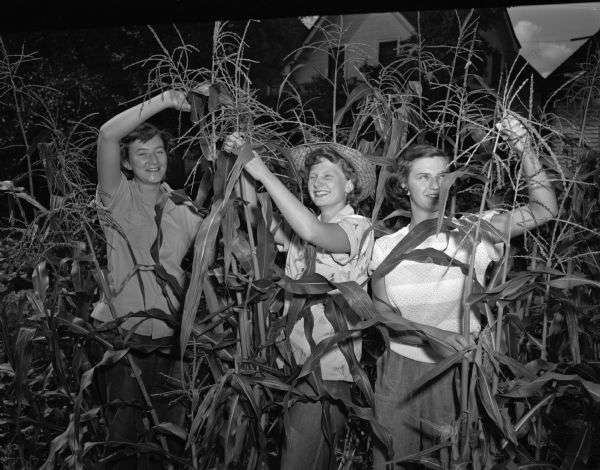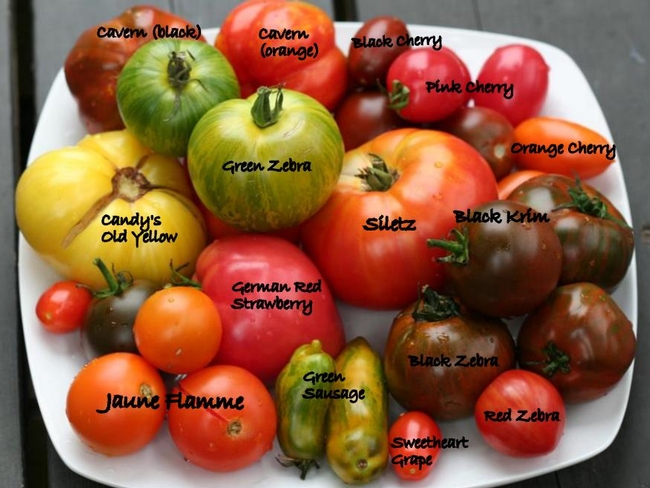 Heirloom vs. Hybrid Seeds - March 13, 2019 Jeff Schalau, Agent, Agriculture & Natural Resources University of Arizona Cooperative Extension, Yavapai County We are in the midst of the spring vegetable and flower seed catalog season. These enticing publications contain terms like hybrid, heirloom, open-pollenated, F1, and more. Clarification of these terms will help you understand the concept of hybridization and provide some insight into which seeds you can and can’t save from your garden to grow in subsequent years. Hybrid seeds are produced through controlled pollination. These seeds are often called "F1" or "F1 hybrids." The terms "hybrid" and "F1" are strictly defined in the seed industry and, when used in seed catalogs, do not apply to plants crossed without human assistance. Some readers may have “detasseled” corn as a seasonal job in the nation’s Corn Belt. Detasseling removes the male flower from specific corn plants so that another specific male parent can pollinate the crop. You may think of a hybrid as blending two different plants, like crossing a red flowered plant with a white flowered plant to get a pink flowered offspring. Unfortunately, genetic expression is often much more complicated than this simplistic example. Most hybridized plants require the cross breeding of carefully chosen parent plants. Specifically, the hybrid seed’s parents must breed true so that the hybrid cross can be repeated with reliability to produce future seed stock. Hybrid seed producers must grow seed for true breeding parent plants in addition to conducting the specific cross to produce the hybrid seed. True breeding parent plants must be “homozygous” for desirable traits. Plants (and other organisms) carry two copies of each gene: one from the male parent and one from the female parent. For example, the gene for seed shape in pea plants exists in two forms, one form or allele for round seed shape (designated “R”) and the other for wrinkled seed shape (designated “r”). A homozygous plant would contain the following alleles for seed shape: (RR) or (rr). When gametes (ovules or pollen) are produced, the number of chromosomes is cut in half and each gamete has one copy of each allele. During fertilization, male pollen combines with the female ovule resulting in seeds and plants having two copies of each gene. Pea plants homozygous for seed shape would have either RR or rr. When an RR parent is crossed with an rr parent, the resulting offspring is said to an F1 hybrid and would have the alleles Rr. The capital R signifies that it is “dominant” meaning that the resulting seed would be round in appearance. However, it also carries the recessive trait (little r = wrinkled) and if these seeds were grown, approximately ¾ would be round and ¼ would be wrinkled. Seeds/plants with two different alleles are said to be “heterozygous” and will not breed true: hence, no seed saving. Some common hybrid tomatoes are ‘Early Girl’ and ‘Celebrity’. If you have followed all of this, you are doing well. I have included additional resources below to help clarify hybridization. If you are an avid vegetable or flower gardener, it is advantageous to understand the basic genetic concepts and how F1 hybrids are produced. “Heirloom” describes a seed’s heritage, specifically a documented heritage of being passed down from generation to generation within a family or community. An heirloom variety of vegetable, fruit, or flower must be open-pollinated—or pollinated by insects, birds, wind, or other natural means—and “breed true,” or retain its original traits from one generation to the next. Heirloom (also called open pollinated) plants are similar to each other but not as uniform as hybrids. Because most were originally chosen for only one or two specific characteristics, individual plants of older heirloom varieties may differ greatly in size, shape, or other traits. Open pollinated varieties are usually grown in fields where they self and cross-pollinate. Plants that cross-pollinate must be isolated from other plants of different varieties so they will produce seed that is "true to type". Genetic "drift" occurs over a period of time. Plants that deviate too far from the accepted standard are removed from commercial nursery fields of open pollinated varieties. Likewise, home gardeners should destroy highly unusual plants if you are trying to save seed from an open pollinated variety. Beans, chicory, endive, English and Southern peas, and tomatoes are self-pollinating so their seeds can be more reliably saved from year to year without having to isolate them (as long as they were not hybrids). Knowing the reproductive characteristics of your plants will improve your seed saving success! Follow the Backyard Gardener on Twitter – use the link on the BYG website. If you have other gardening questions, call the Master Gardener help line in the Camp Verde office at 928-554-8992 or e-mail us at verdevalleymg@gmail.com and be sure to include your name, address and phone number. Find past Backyard Gardener columns or provide feedback at the Backyard Gardener web site: http://cals.arizona.edu/yavapai/anr/hort/byg/. Photos  Many youth have detasseled corn as a summer job. By removing the tassel, hybrids can be produced by introducing pollen from another parent plant (Wisconsin Historical Society Photo).
Many youth have detasseled corn as a summer job. By removing the tassel, hybrids can be produced by introducing pollen from another parent plant (Wisconsin Historical Society Photo). Heirloom tomatoes are popular with many Backyard Gardeners (University of California ANR, UC Master Gardeners of Napa County).
Heirloom tomatoes are popular with many Backyard Gardeners (University of California ANR, UC Master Gardeners of Napa County).Additional Resources Hybrid Varieties and Saving Seed, Texas A & M Agrilife Extension, (Undated) http://aggie-horticulture.tamu.edu/archives/parsons/vegetables/seed.html Pollination of Vegetable Crops, University of Georgia Extension extension.uga.edu/publications/detail.html?number=C934&title=Pollination%20of%20Vegetable%20Crops Mendelian Genetics, North Dakota State University, Philip McClean ©, 2000 http://www.ndsu.edu/pubweb/~mcclean/plsc431/mendel/mendel2.htm |